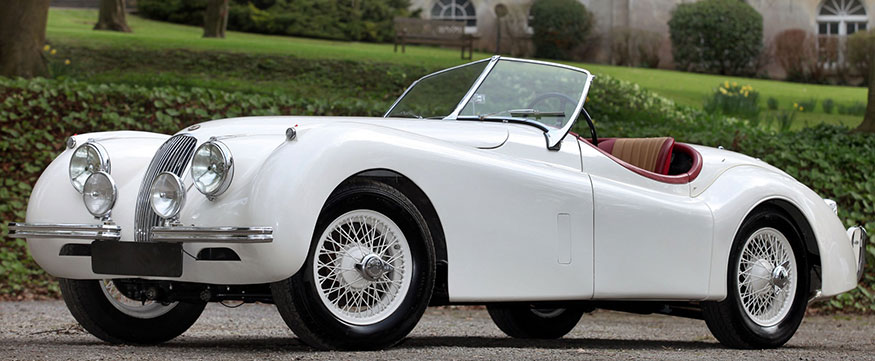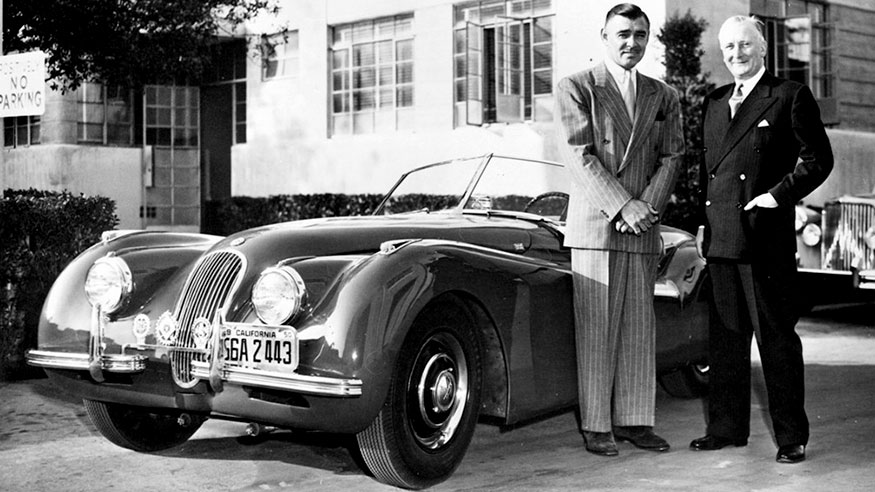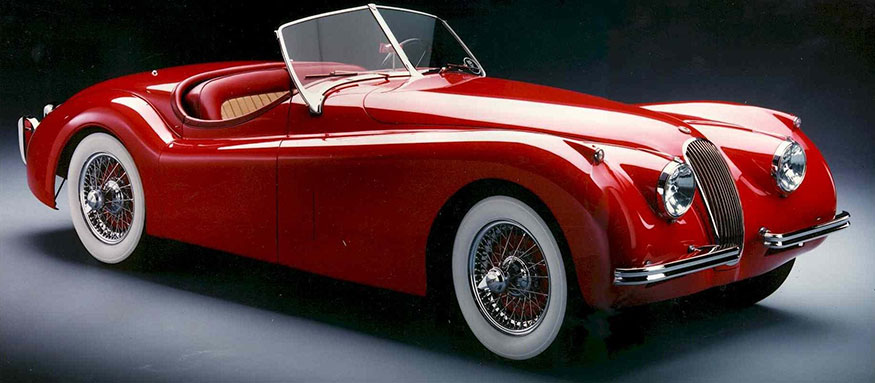THE JAGUAR XK120

If I were dreaming of a classic sports car as I often am, the name Swallow Sidecar Company just would not cut it for me.
On the other hand, if it were renamed the JAGUAR and you were to add on the model designation XK 120, with the 'X' standing for experimental and 120 being a top speed of 120 mph,(this, notably, in the early 1950's) and I am well and truly hooked.
William Lyons, obviously thought along the same lines (cannot resist a reference to 'great minds' here) and took his car company through several name changes from the Twenties to the Mid-forties, up to the arrival in 1948 of the Jaguar XK 120, the embodiment of style, savage grace and effortless pace, a legendary car much coveted and sought after by enthusiasts to this day.

The Jaguar XK 120. Clark Gable and Sir William Lyons a.k.a. "Mr. Jaguar"
From a harmless little bird to a deadly cat, she remains every boy and old man's enduring fantasy, easily outliving the pussy phase.
Somewhere along the way, Lyons made and sold a car tagged the SS 100, SS for Standard Swallow, 100 for miles per hour, top speed. Post WW2,the appearance of the XK 120, inspired by the BMW 328 of German origin, quite ironically, coincided with a switch from the name SS with its sinister connotations, to the iconic Jaguar brand.
It was the SS 100 with its elegantly flared mud guards and running boards which gave way to the XK 120,with a form evocative of a crouching cat poised to leap a striking visual, perfectly echoed by the mascot on the bonnet.
A star was born.
The XK 120 was offered in several forms, roadster, coupe and drophead coupe. The straight six 3.4 litre long-stroke engine delivered an adequate low-end surge, the car was an enthusiasts dream. An aluminium head housing double overhead camshafts stamped the sporting pedigree, not forgetting the twin SU carbs through which the naturally aspirated engine drew petrol-laden breath, together making for a heady and intoxicating mix.
Unfortunately neglected, one of the few downsides was ergonomics, a word which made its first appearance in the English lexicon in 1949, around the same time the XK was conceived. Gentlemen of diminutive stature, to be politically correct, will have no problem behind the wheel, but a gent touching the two yard mark will end up wishing his mum had gone easy on the growth tonics by the tail-end of a long drive,by which time his own tail-end would be more than sore.
On the competition front the big cat was no lazy kitty, being led to a 1-2-3 finish in the Tourist Trophy by no less a legend than Stirling Moss, one day short of his 21st birthday. With wins on both sides of the Atlantic, the XK 120 made its way to America in no small numbers, where many a car is still in action today. Sadly, no more than a handful of these beauties survive in India, most being in the hands of wealthy collectors, more than a few having left our shores, both legally and illegally over the past few decades, some of these beasts ignominously listed as "Tractor spares" in fraudulent Bills of Lading.
For the past few years ownership of this aspirational brand is vested in the House of Tatas, known for their integrity and foresight. In a twist of time and fate, Mr.Ratan Tata, a former subject of Her Majesty's Lost Empire was responsible for the creation of several thousand jobs at the Jaguar works in the UK marked by a turn-around in the fortunes of the brand.

As for acquiring these superb cars today, prices across all generations and models range from half a crore to a couple of crores, with classics like the XK120 and her younger siblings, the XK 140 and XK 150 (here again, 140 and 150 refer to miles per hour) at the top of the pile, relegating them to dream material for most of us.
Last word, with "Tata" in the driver's seat, hope we will never have to say "Bye" to the Jag, as we loved it then and know it today.

